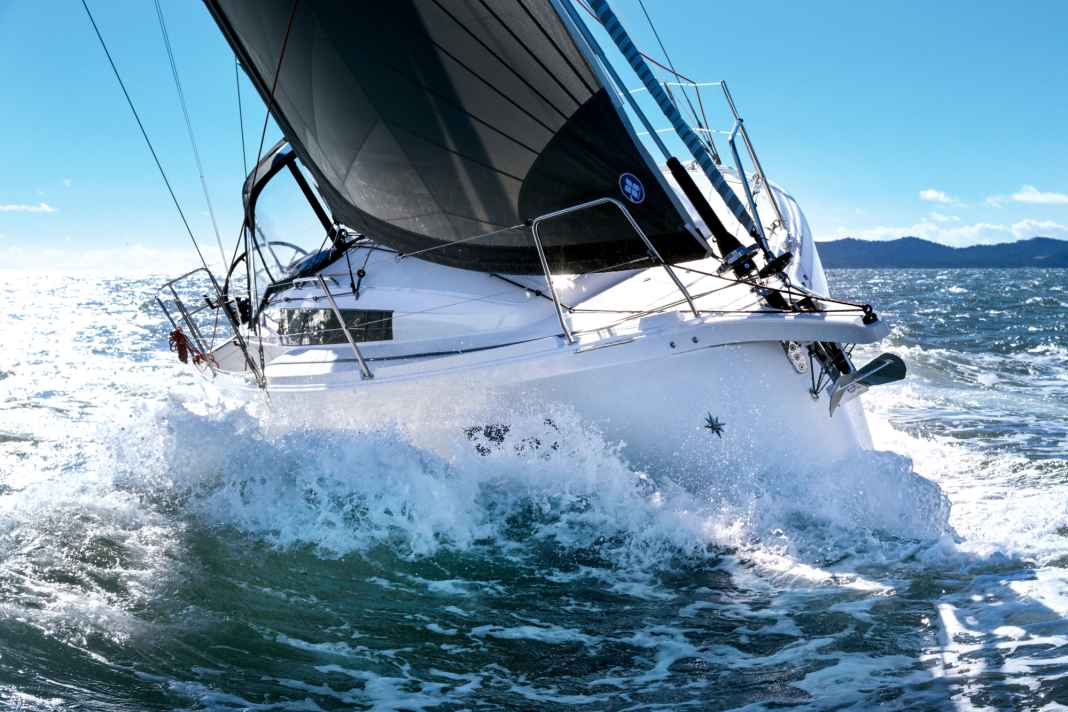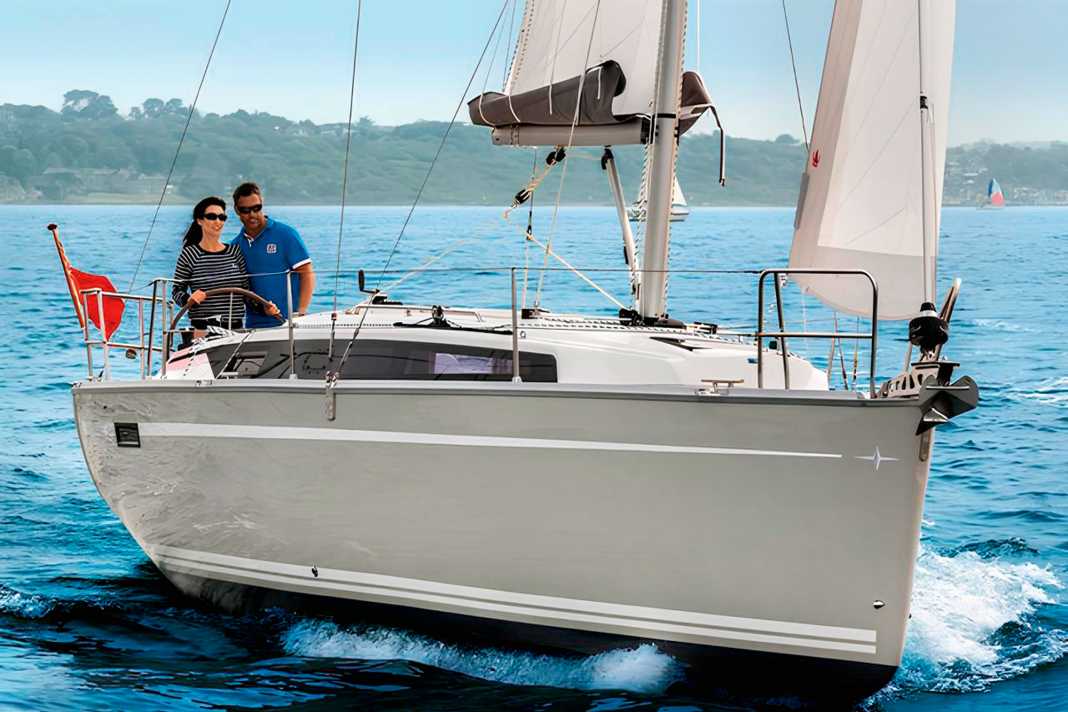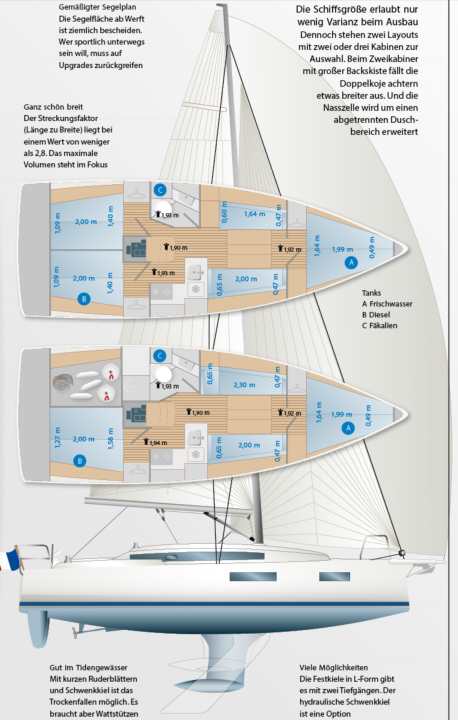





- Attractive, versatile, but also older in some cases. This is the competition
- The walkaround cockpit on smaller boats
- Sporty sailing with a sail upgrade
- Sun Odyssey 350 shows impressive performance values
- Walkaround cockpit demands compromises
- No major blunders
- Price trend remains exciting
- The measured values for the test of the Sun Odyssey 350
- The Sun Odyssey 350 in detail
- Equipment, price and shipyard
- YACHT review of the Sun Odyssey 350
In spring 2017, Jeanneau surprised everyone with the first production boat to feature an innovative walkaround cockpit. The idea: the running decks lower towards the rear like ramps to the level of the cockpit floor, allowing a barrier-free passage from the cockpit around the steering columns to the foredeck and back. This means you no longer have to laboriously climb over the coamings to get to the front.
Also interesting:
Since the presentation of the concept with the Sun Odyssey 440 (Test YACHT 16/2017), seven years have passed. Jeanneau has used this time to thoroughly revise the entire Sun Odyssey cruising range and convert all models between 10 and 14 metres in hull length to the new walkaround cockpit. Even the larger yachts in the upper range now have stepless walkarounds in the cockpit.
However, it was and is clear that it would be difficult to transfer the expansive concept to the smaller models in the cruising range. So it was all the more surprising that two years ago Jeanneau launched the eleven metre long Sun Odyssey 380 and has now followed this up with the small Sun Odyssey 350, a boat for the popular and highly competitive ten metre hull length class. Both boats also have a walkaround cockpit. The new 350 was presented as a world premiere at boot Düsseldorf in January. The YACHT editorial team has now been given the opportunity to put the boat to the test for an exclusive test in the south of France.
Attractive, versatile, but also older in some cases. This is the competition






The walkaround cockpit on smaller boats
The Sun Odyssey 350 is taking on a difficult legacy. It has to replace the Sun Odyssey 349, which became a bestseller for Jeanneau over a period of ten years. The French company has built around 1,400 units of this type. The new 350 is not dissimilar to its predecessor, but has clear differences in terms of design. The design by Marc Lombard is no less than 15 centimetres wider than its predecessor. With the same hull length of 9.99 metres, this is quite a lot, but at the same time it is also a requirement in order to still be able to implement the walkaround idea sensibly without sacrificing a lot of space in the cockpit.
In addition to the increase in width, the hull lines have also become much fuller, especially in the foredeck area - a general trend in yacht building at present. In addition, the freeboards drop almost vertically, especially aft, and the chine edges are more pronounced. In addition to gaining space for the interior fittings, the additional volume is primarily intended to make the sailing characteristics more balanced, especially as compensation for the stern, which remains wide aft.
Like its predecessor, the new Sun Odyssey 350 can also be ordered with either fixed L-shaped keels and two companionways or with an electro-hydraulically operated swivelling keel, with which the boat can even easily fall dry. However, this requires wading props, which are also available as an option. The rig is now positioned further aft to compensate for the additional hull volume at the front of the boat. This increases the foresail triangle and thus the sail area for the standard genoa or the optional self-tacking jib.
Sporty sailing with a sail upgrade
In return, the main boom is slightly shorter than on the previous model and the mast is slightly higher. If you want to utilise the full potential of the Sun Odyssey 350 and also want to sail sportily, you should therefore opt for the sail upgrade with laminate cloth and a mainsail with a flared top. This is easy to do and can also be retrofitted because the mast from manufacturer Seldén is driven without a backstay.
The test boat is also equipped with the powerful wardrobe. The conditions for the test in the Bay of Hyères are perfect with a mistral situation: between 15 and 18 knots of wind on average, very gusty with many turns and crisp pushes of up to 25 knots. On the downwind leg with mainsail and genoa, the boat is a little bitchy at first and is challenging to steer, which is not entirely unusual for the designs from Marc Lombard's office. The ride becomes more stable with the Code Zero furled, which allows even the strongest gusts to be easily parried. With a little wave support, the log even shows a speed of around 10 knots, which is quite a lot for a cruising boat of this size.
Sun Odyssey 350 shows impressive performance values
The Sun Odyssey 350 also puts in a strong performance upwind. The boat sails stiffly and true to course, even in the strong gusts and despite full sails and a ballast ratio of less than 30 per cent in the standard deep keel with lead bulb. The high dimensional stability of the wide Lombard hull with its pronounced uphaul is very noticeable. Even with deliberately forced heeling, the boat remains manoeuvrable, and ruddering is not an issue. The two relatively short rudder blades work well and the boat reacts lively. And the Sun Odyssey 350 can run a surprisingly good height. After several tacks, a turning angle of 80 degrees can be determined in the test, at a speed of 6.4 knots against. These are impressive performance values for a boat of this size, even when you consider the potential increase in performance with the performance upgrade and the better sails on the test boat.
The basic equipment for the Sun Odyssey 350 includes two self-tailing 40 mm winches aft for the mainsail and headsail sheets. When manoeuvring with the genoa, the lines have to be stopped and relaid on the other side. With a little practice, however, this works perfectly and the helmsman can still easily reach the sheets and winches from his position behind the wheel. In this respect, the layout on deck is still suitable for single-handed sailing, even with the short overlapping genoa.
The double-sided mainsheet (German Cupper) runs over a sheet triangle on the coachroof, but is positioned very far forward, in front of the centre of the boom. This means more effort is required to hoist and trim the mainsail. This is an issue on the Sun Odyssey 350 because the equipment concept does not provide for a backstay or a traveller, so a lot of work has to be done with the sheet.
Walkaround cockpit demands compromises
With the running deck recessed aft, the helmsman has no opportunity to sit sideways directly behind the steering wheel as is usually the case. So that he does not have to stand permanently during his work, two small seats are moulded diagonally between the stern and the outside of the hull, close to the pushpit. Here, the helmsman can sit reasonably comfortably upwind and downwind, but at a relatively large distance from the wheel, which makes steering with outstretched arms strenuous in the long run. The standing position is therefore the better option on courses with a lot more work on the wheel. This is where the walkaround idea demands clear compromises.
The interior remains essentially unchanged compared to the previous model, with the exception of details and visual adjustments. Customers can choose whether they want their boat with three double cabins or with two compartments and a large cockpit accessible from the outside and inside. In the case of the two-cabin version, owners can look forward to a particularly large wet room with a separate shower room and plenty of room to move around. The layouts illustrate the feasibility. These variants are also offered in a similar form by the competition within the entry-level class, with the size of the boat limiting the possibilities.
No major blunders
A sober but not uncomfortable functionality characterises the overall appearance of the interior. The symmetrical layout in the saloon offers two additional sleeping options on the sofas, which increases the maximum number of berths on board to eight. A small navigation system is available as an option for an extra charge. However, its work surface is not large enough for working with the nautical chart. The interior fittings are essentially neat and robust. However, there are also some minor imperfections that are due to large-scale production on the assembly line. For example, the gap dimensions do not match everywhere and the cut edges of the plywood furniture components are neither sanded nor sealed with varnish in many places.
In the foredeck, the double berth is 1.64 metres wide at shoulder height, which is significantly more than on the previous model and is of course a result of the increased hull volume. However, the berth is still built far into the bow, which restricts the height of the feet and is annoying when double occupancy. Compared to the previous model, the aft berths have remained the same width due to the restrictions imposed by the walkaround cockpit. Only 1.40 metres are available here in the area of the shoulders, which according to the YACHT definition is just the lower limit for a barely practicable double berth for two adults. When fitted with two cabins and a large aft locker, the longitudinal bulkhead is moved 18 centimetres to port. This increases the width of the berth accordingly, a good solution.
Price trend remains exciting
With a base price for the Sun Odyssey 350 of around 160,300 euros, Jeanneau is taking a middle course when looking at the competition. The ten-metre boats from Hanse, Beneteau and Maxus are in the same price range. The Dufour is slightly more expensive, the Bavaria cheaper. In terms of model development, the price comparison with the Sun Odyssey 349 is exciting. The predecessor model was recently on offer for around 150,000 euros gross, a good 10,000 euros cheaper than the 350. However, the new boat now comes with better basic equipment from the shipyard. For example, Jeanneau delivers the boat with a boiler and hot water supply, an additional hull window in the foredeck and a more powerful diesel engine with 29 hp as standard. These amenities were previously only available at extra cost.
With the Sun Odyssey 350, Jeanneau has developed an honest, no-frills cruising boat for a wide range of uses. Cosy family sailors will get their money's worth just as much as those who like it sportier and more active. The shipyard has also put together a whole range of attractive equipment packages for customers to benefit from. The new boat marks the completion of the extensive overhaul of the Sun Odyssey cruising range. The walkaround concept has become a kind of identity for Jeanneau, a trademark and a unique selling point. An advantage for the French company - even over the competition.
Sailing business booming, returns considerable

Jeanneau is part of the Beneteau Group, by far the world's largest boatyard. And it has had an astonishing twelve months under full sail. This is demonstrated by the recently presented balance sheet of the listed company.
"2023 was a record year," said Bruno Thivoyon, CEO of the Group, which also includes Lagoon, Excess, Seascape and more than half a dozen motorboat brands, summarising the results. Total turnover climbed by more than 17 per cent to almost 1.5 billion euros. The increase in earnings before interest, taxes, depreciation and amortisation was almost twice as strong. They increased by 32 per cent to 262 million euros. This corresponds to a gross profit margin of 17.9 per cent. In other words: Beneteau earned 90 million more than Hanseyachts' total turnover.
The impressive performance is based on a programme to increase profitability. However, increased demand in the sailing yacht segment also contributed to this; sales in this segment rose by 31 per cent, while motorboat sales declined slightly. Two factors contributed to this shift: Firstly, sales of sailing boats to charter companies increased disproportionately, and secondly, the proportion of large, high-margin yachts increased.
Several boat builders recently presented positive annual financial statements. It is a late reflection of the coronavirus boom. Beneteau, however, clearly outperformed the competition in every single segment. And the French company remains optimistic. For 2024, they expect a net return of seven to ten per cent; last year it was 10.2 per cent.
The measured values for the test of the Sun Odyssey 350





The Sun Odyssey 350 in detail

Technical data of the Sun Odyssey 350
- Designer: Marc Lombard Yacht Design
- CE design category: A
- Torso length: 9,99 m
- Total length: 10,94 m
- Waterline length: 9,38 m
- Width: 3,59 m
- Draught/alternative: 1,98/1,49 m
- Draught Swivelling keel: 1,28-2,54 m
- Mast height above WL: 15,80 m
- Theor. torso speed: 7.4 kn
- Weight: 5,66 t
- Ballast/proportion: 1,58 t/28 %
- Mainsail: 31,6 m²
- Furling genoa (110 %): 23,4 m²
- machine (Yanmar): 21 kW/29 hp
- Fuel (rotomould): 130 l
- Fresh water (rotomould): 206 l
- Black water (Rotomold): 80 l
Hull and deck construction
Hull: GRP full laminate in hand lay-up. Deck: GRP sandwich, built using vacuum injection (RTM)
Equipment, price and shipyard
- Base price ex shipyard: 160.295 €
- Standard equipment included: Engine, sails (main and genoa), sheets, railing, navigation lights, battery, compass, cushions, galley/cooker, bilge pump, toilet, fire extinguisher, electric cooler, waste-holding tank with suction system
- For an extra charge: Sailcloth € 1,055, anchor with chain € 1,150, fender/mooring € 525, antifouling € 2,970, clear sailing handover € 5,340
- Price ready to sail: 171,335 € (all prices as of 5/24)
- Guarantee/against osmosis: 3/3 years
How the prices shown are defined can be found here!
Surcharge for comfort equipment
- Hole points: incl.
- Traveller: not available
- Electric windlass: Trim level
- Tube kicker: Trim level
- Backstay tensioner: not available
- Jumping cleats: incl.
- Sprayhood: 1.830 €
- Teak in the cockpit: 2.500 €
- VHF radio: E-Pack Cruising
- Log and echo sounder: E-Pack Cruising
- Wind measuring system: E-Pack Cruising
- Autopilot: E-Pack Cruising
- Electronic Pack Cruising: 9.760 €
- Charger: Trim level
- Land connection: Trim level
- 230 volt socket (one): incl.
- 12-volt socket in the sat nav: incl.
- Heating: 6.485 €
- Pressurised water system: incl.
- Hot water boiler: incl.
- Shower WC room: incl.
- Cockpit shower: 560 €
- Comfort price: 192.470 €
Included in the price: German-Cupper mainsheet system, walkaround cockpit, cockpit table (simple version), two-burner cooker with oven
Trim Level equipment package
Tube kicker, windlass with remote control, Corian work surface, USB sockets, shore connection with 220 V sockets, battery charger and more cost €12,020
Rig and sail
Aluminium mast from manufacturer Seldén with two spreaders and wire shrouds (1x19 stainless steel). Mainsail and genoa (110 per cent) as standard. Self-tacking jib, code zero or gennaker optional
Motorisation
Standard Yanmar three-cylinder built-in diesel (3YM30) with shaft drive and three-blade fixed propeller. Optional electric pod drive from Torqeedo (6 kW, plus 3,450 euros)
Shipyard
Chantiers Jeanneau; 85500 Les Herbiers; www.jeanneau.com
Distribution
Dealer network
YACHT review of the Sun Odyssey 350
Honest and straightforward cruising concept from Jeanneau. The innovative walkaround cockpit makes the Sun Odyssey 350 something special compared to the competition. The sailing characteristics are convincing and the price is also right
Design and concept
- + Innovative cockpit layout
- + No frills concept
- + Coherent pricing
- + High level of customisation
Sailing performance and trim
- + Good height in the wind
- + Sails stiffly and true to course
- + One-handed suitability
- - Seated position at the steering wheel
Living and finishing quality
- + Quiet and cosy inside
- + Good ventilation options
- - Width of aft berths narrow
- - Partially unclean processing
Equipment and technology
- + Extensive basic equipment
- + Robust construction
- - Bathing platform only as an extra
- - Mainsheet control needs strength

